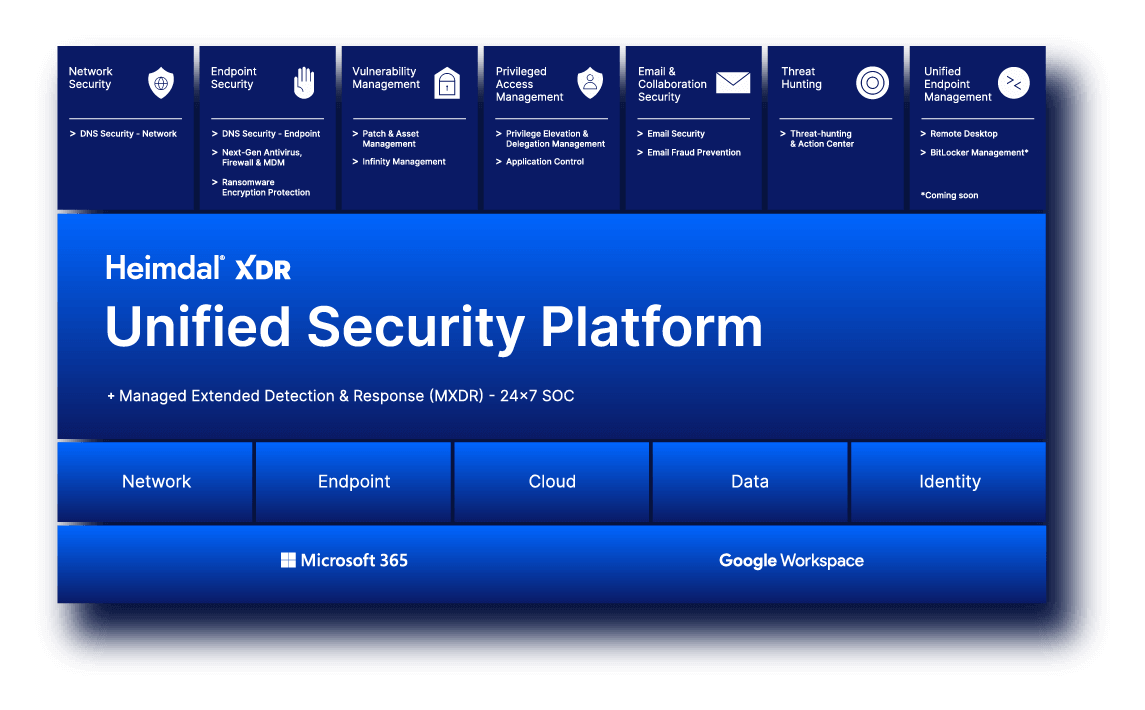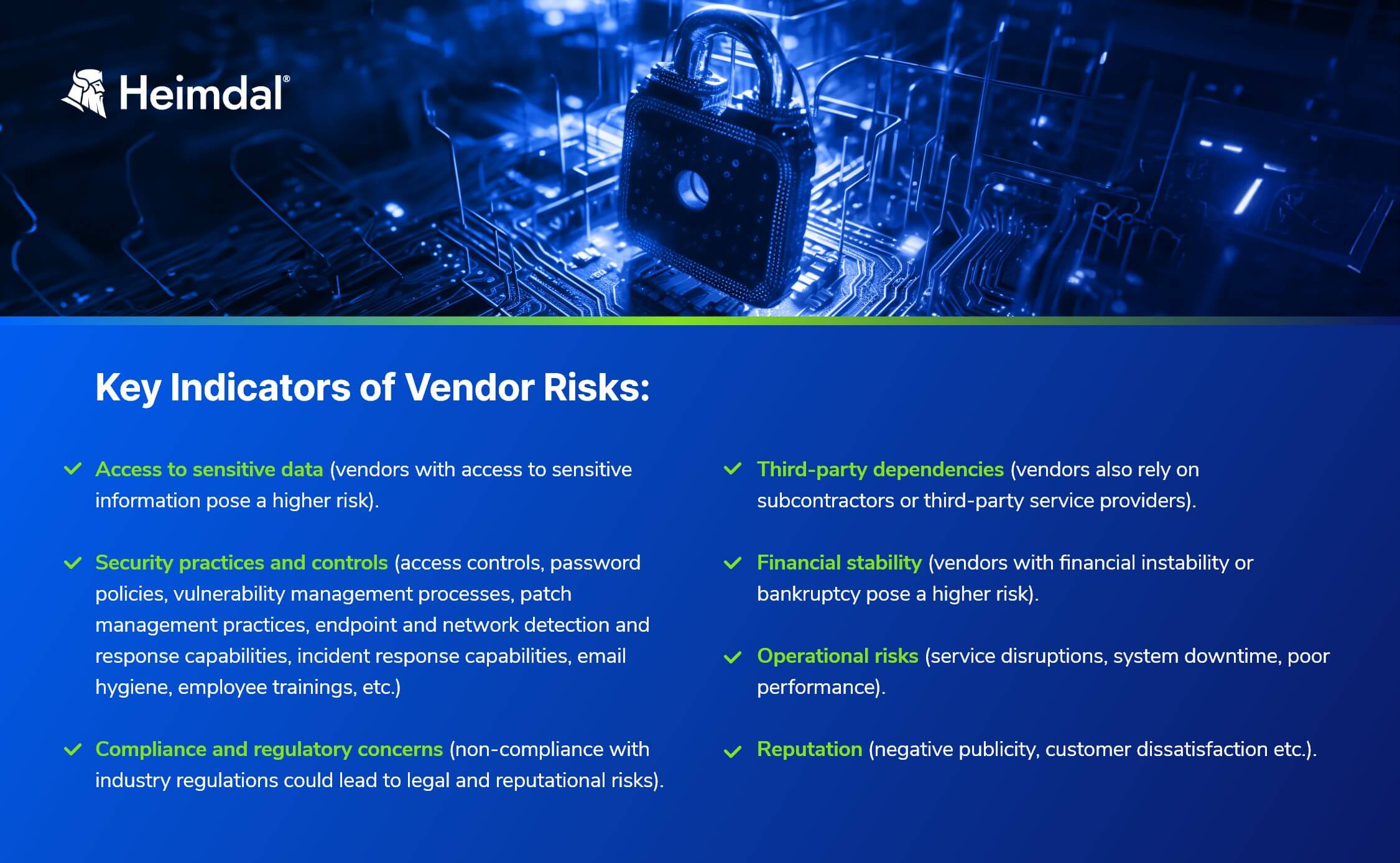Contents:
In the ever-evolving and intricate realm of modern business, organizations rely heavily on various vendors and third-party partners to keep their operations running smoothly. However, this dependence introduces significant cybersecurity risks, which is why the practice of vendor risk management has recently gained traction.
In this blog post, we will explore the definition of vendor risk management, the responsible parties, differentiate VRM from third-party risk management and supply chain risk management, delve into key indicators of vendor risks, outline the steps to conduct a vendor risk assessment, and discuss how cybersecurity solutions can enhance the vendor risk management process.
So let’s dive right in!
Defining Vendor Risk Management
Vendor risk management (VRM) is a systematic approach that helps organizations evaluate and manage the potential risks associated with their third-party vendors. It aims to safeguard sensitive data, protect the organization’s reputation, and ensure business continuity.
VRM involves a range of activities, including assessing vendor security controls, monitoring their performance, and implementing strategies to mitigate identified risks.
Vendor risk management empowers IT security teams to take proactive measures, leverage their expertise, and ensure that the organization’s sensitive data remains secure, its reputation intact, and its operations resilient in the face of evolving cyber threats.
Who Is Responsible for Managing Vendor Risks?
Vendor risk management is a collaborative effort that involves multiple stakeholders within an organization. Depending on the size of the organization, the responsibility for VRM is typically shared among the following parties:
- Procurement and Vendor Management Teams: They are responsible for vendor selection, due diligence, contract negotiations, and ongoing relationship management.
- Information Security Teams: They play a vital role in assessing vendor security controls, conducting audits, and ensuring compliance with security standards.
- Executive Leadership: Senior executives provide the necessary support, resources, and oversight for effective vendor risk management initiatives.
Conducting a Vendor Risk Assessment
A vendor risk assessment is a systematic process that allows organizations to evaluate the cybersecurity risks associated with their vendors. It usually involves the following steps:
1.Vendor Identification and Categorization: Identify all vendors and categorize them based on the level of risk they pose to the organization.
2. Risk Evaluation: Assess the identified vendors against predetermined risk criteria, considering factors such as data access, security controls, compliance, and financial stability.
3. Risk Mitigation: Develop risk mitigation strategies based on the assessment results. This can include contract negotiations, implementing additional security controls, or seeking alternative vendors.
4. Ongoing Monitoring: Continuously monitor vendors’ security posture through periodic audits, security questionnaires, and vulnerability assessments.
Evaluating Vendor Risks
Identifying and evaluating vendor risks is a critical step in the VRM process. The criticality of the vendor’s services, the nature of the data shared with them, and the vendor’s security posture are all factors to be considered. Some key indicators of vendor risks include:
Access to Sensitive Data – Vendors with access to sensitive information pose a higher risk, especially if adequate security controls are not in place.
Security Practices and Controls – Evaluating a vendor’s security practices, including policies, employee training, access controls, and incident response capabilities, helps identify potential vulnerabilities.
Compliance and Regulatory Concerns -Vendors that fail to meet regulatory requirements or lack proper compliance measures may expose organizations to legal and reputational risks.
Financial Stability – Assessing a vendor’s financial stability is crucial, as financial difficulties or bankruptcy can disrupt services and potentially expose sensitive information.
Vendor Reputation and Track Record – A vendor’s reputation, experience, and past incidents can indicate their reliability and security posture.
What Is a Vendor Management Risk and Control Matrix?
A management risk and control matrix is a useful tool for analyzing and controlling potential threats from external sources. It maps specific risks associated with them and identifies corresponding controls to mitigate those risks.
The matrix serves as a reference point for evaluating and categorizing third parties based on their risk levels, enabling organizations to allocate appropriate resources and implement relevant controls. Here’s an example (NASA).
VRM vs TPRM vs SCRM
Although the main principle is the same – evaluating one or more third parties, vendor risk management (VRM) is not the same as third-party risk management (TPRM), or supply chain risk management (SCRM). That’s because vendor risk management focuses only on, as its name suggests – vendors.
TPRM encompasses a broader scope, covering risks associated with all types of third-party relationships, including vendors, suppliers, contractors, and service providers. TPRM evaluates risks across the entire vendor ecosystem, whereas VRM specifically targets risks associated with individual vendors.
SCRM, on the other hand, focuses on managing risks across the entire supply chain, which includes multiple tiers of suppliers and their dependencies. It evaluates risks that can arise from any point within the supply chain network, including vendors.
How Can Heimdal® Help?
Whether you’re a vendor or a company engaging with vendors, a robust cybersecurity posture is non-negotiable. The best way to secure your assets is by implementing a multi-layered cybersecurity approach that includes: software visibility, vulnerability management, privilege access management, DNS filtering, patch management, email security, and proactive threat hunting among others.
Luckily, from endpoints and networks to emails, identities, and beyond, we have you covered with advanced, state-of-the-art detection and response capabilities.
With a unique approach to cybersecurity, through an XDR platform that constantly adapts and evolves by tracking the movements of cybercriminals and building incremental intelligence, Heimdal secures the future of some of the world’s leading organizations.
Rest easy as we help you contain sophisticated cyber threats and minimize vendor risks, so that you focus on what you do best – your business. Also, we support you in achieving compliance with industry standards such as GDPR, Cyber Essentials, NIST Framework, HIPAA and more.
Ready to level up your cyber resilience? Book a demo and explore further!
Wrap up
Vendor risk management is an essential aspect of cybersecurity strategies, as organizations increasingly rely on third-party vendors. By implementing robust VRM practices, organizations can identify, assess, and mitigate the risks associated with vendors, safeguarding their sensitive data and maintaining a resilient security posture.
If you liked this article, follow us on LinkedIn, Twitter, Facebook, and Youtube, for more cybersecurity news and topics.


 Network Security
Network Security
 Vulnerability Management
Vulnerability Management
 Privileged Access Management
Privileged Access Management
 Endpoint Security
Endpoint Security
 Threat Hunting
Threat Hunting
 Unified Endpoint Management
Unified Endpoint Management
 Email & Collaboration Security
Email & Collaboration Security












